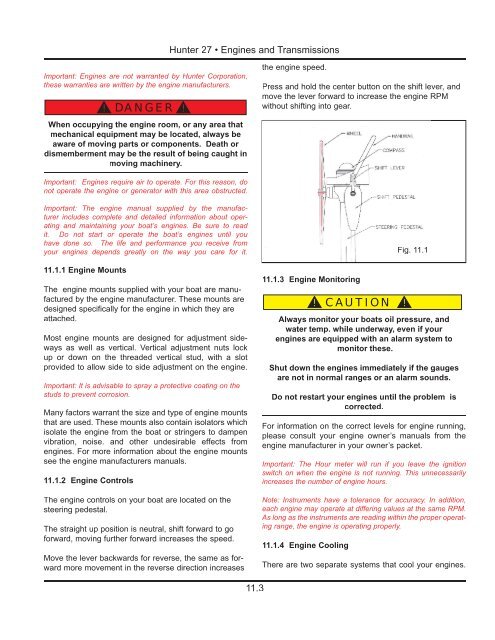27 Operator's Manual.. - Marlow-Hunter, LLC
27 Operator's Manual.. - Marlow-Hunter, LLC
27 Operator's Manual.. - Marlow-Hunter, LLC
Create successful ePaper yourself
Turn your PDF publications into a flip-book with our unique Google optimized e-Paper software.
<strong>Hunter</strong> <strong>27</strong> • Engines and Transmissions<br />
Important: Engines are not warranted by <strong>Hunter</strong> Corporation,<br />
these warranties are written by the engine manufacturers.<br />
! DANGER !<br />
When occupying the engine room, or any area that<br />
mechanical equipment may be located, always be<br />
aware of moving parts or components. Death or<br />
dismemberment may be the result of being caught in<br />
moving machinery.<br />
the engine speed.<br />
Press and hold the center button on the shift lever, and<br />
move the lever forward to increase the engine RPM<br />
without shifting into gear.<br />
Important: Engines require air to operate. For this reason, do<br />
not operate the engine or generator with this area obstructed.<br />
Important: The engine manual supplied by the manufacturer<br />
includes complete and detailed information about operating<br />
and maintaining your boat’s engines. Be sure to read<br />
it. Do not start or operate the boat’s engines until you<br />
have done so. The life and performance you receive from<br />
your engines depends greatly on the way you care for it.<br />
11.1.1 Engine Mounts<br />
The engine mounts supplied with your boat are manufactured<br />
by the engine manufacturer. These mounts are<br />
designed specifically for the engine in which they are<br />
attached.<br />
Most engine mounts are designed for adjustment sideways<br />
as well as vertical. Vertical adjustment nuts lock<br />
up or down on the threaded vertical stud, with a slot<br />
provided to allow side to side adjustment on the engine.<br />
Important: It is advisable to spray a protective coating on the<br />
studs to prevent corrosion.<br />
Many factors warrant the size and type of engine mounts<br />
that are used. These mounts also contain isolators which<br />
isolate the engine from the boat or stringers to dampen<br />
vibration, noise. and other undesirable effects from<br />
engines. For more information about the engine mounts<br />
see the engine manufacturers manuals.<br />
11.1.2 Engine Controls<br />
The engine controls on your boat are located on the<br />
steering pedestal.<br />
The straight up position is neutral, shift forward to go<br />
forward, moving further forward increases the speed.<br />
Move the lever backwards for reverse, the same as forward<br />
more movement in the reverse direction increases<br />
11.1.3 Engine Monitoring<br />
! CAUTION !<br />
Always monitor your boats oil pressure, and<br />
water temp. while underway, even if your<br />
engines are equipped with an alarm system to<br />
monitor these.<br />
Shut down the engines immediately if the gauges<br />
are not in normal ranges or an alarm sounds.<br />
Do not restart your engines until the problem is<br />
corrected.<br />
For information on the correct levels for engine running,<br />
please consult your engine owner’s manuals from the<br />
engine manufacturer in your owner’s packet.<br />
Important: The Hour meter will run if you leave the ignition<br />
switch on when the engine is not running. This unnecessarily<br />
increases the number of engine hours.<br />
Note: Instruments have a tolerance for accuracy. In addition,<br />
each engine may operate at differing values at the same RPM.<br />
As long as the instruments are reading within the proper operating<br />
range, the engine is operating properly.<br />
11.1.4 Engine Cooling<br />
There are two separate systems that cool your engines.<br />
11.3

















